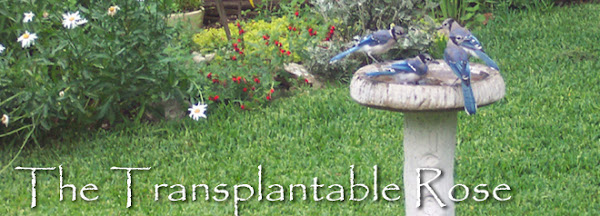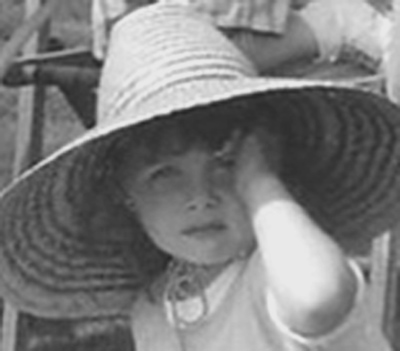{Most photos enlarge when clicked.}
Unlike the sweltering summer of 2009, this July hasn't topped 100°F yet and there has been real rain. We love looking out at the garden and birdbath fountain from the breakfast room.

The 'Little Gem' Magnolia has a few flowers, orange cosmos and self-seeded sunflowers add bright colors to the center of the back garden and a blue/purple haze near the yellow chair contrasts with the shockingly green grass.

Those purple, white and blue colors come from a 'Catawba' crepe myrtle, Mealy-blue sage, 'Miss Tilly' balloon flowers, a division of the 'Blue River II' hibiscus and 'Diamond Frost' euphorbia.

Behind the euphorbia is Salvia vanhouttei, of doubtful hardiness, but at $2 for a starter plant that's already shrub-size, worth growing because the hummingbirds love it.
It looks like this now... a little ragged but still intense in color - and you can see that it seems designed for hummingbird bills!

Ten days ago I caught the partially opened buds - part of a Red, White & Blue post that never happened.

In the smaller triangle the starter plants of 'Black Pearl' pepper are settling in, with white, yellow and orange Portulaca around it. This year I added some stubbier Flowering Purslane to the reseeded and more delicate Moss Rose types. White Zinnia linearis also reseeds, adding daisy shapes to the scene.

In the larger triangle bed it was a surprise to see that the Hemercallis fulva (AKA Ditch daylily, a passlaong from Lori) sent up a scape loaded with buds. It bloomed in May - what is going on? At the left on the obelisk you can see leaves of the Blue Butterfly Pea winding upward in preparation for an appearance at the August GBBD.

Perennials are wonderful, but Green Bones that add mass and form along with bloom give solid satisfaction - here is the 'Little Gem' magnolia framed by white semi-dwarf 'Acoma' crepe myrtles, my neighbor's common pink crepe and a froth of evergreen Abelia at mid-level.

Along the bed to the left the Cenizo/Purple Sage is in full bloom - some people say the blooms are a promise of rain, but others say it's a response to rain. Another nickname for this plant is "Barometer Bush".

Near the back door the blue Plumbagos have rebounded from last winter's freezeback, blooming blue with a self-seeded tropical Milkweed and the purple oxalis which has decided to rebloom rather than go dormant.

A few feet away the first blooms have opened on Amarcrinum 'Fred Howard' - pink and fragrant.

On the patio the Blue Butterfly Clerodendron looks a little smug after being the subject of its own post last week.

Around the corner in the Secret Garden green prevails, with color coming from a tall crepe myrtle showering watermelon-pink petals from high overhead, a few coral-pink canna buds at the 3-foot level and this pink false indigo down close to the ground.

There's a new pink flower in the Pink Entrance Garden - John Fanick's phlox. The passalong phlox that came from my Illinois grandmother is barely alive and not blooming but this Texas Superstar was selected to do well here.

Another passalong from Illinois seems to like Texas just fine - it's a small, reblooming daylily bought at Mileager Nurseries of Wisconsin in the mid-1990's as 'Pinocchio'. Every summer it has an initial flush of bloom, rests and regroups, makes a smaller number of scapes, rests a little longer, then pops a few more. Those are more 'Miss Tilly' balloon flowers in the background.
 By next week a list of everything in bloom today with botanical names will go up at Annie's Addendum...
By next week a list of everything in bloom today with botanical names will go up at Annie's Addendum...but next up will be the TOMATO REPORT, a long overdue post with a new song.
Have fun checking out a world of garden blogs in bloom right here.
JULY 22, 2010
The complete list of blooms with botanical names and a few more photos is now up at Annie's Addendum








